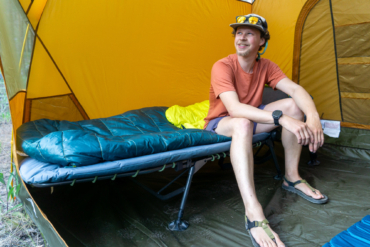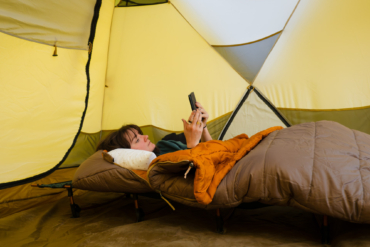Dave and Amy Freeman literally spent a full year in the backcountry. So they know what to pack and what to leave at home for an efficient trip into the wilderness.
In 2015 and 2016, the Freemans spent an entire year in the Boundary Waters Canoe Area. And in doing so, they learned priceless tips on how to pack for outdoor adventures.
Here, they share their top tips on packing for the backcountry. Want to know more about their specific gear? Check out some of their favorite gear for the Boundary Waters Canoe Area here.
Packing Tips for the Backcountry
1. Less Is More
The gear you bring for a weekend climbing trip in Joshua Tree, a wilderness canoe trip in the Boundary Waters, or a winter ascent of a 14er in Colorado will be vastly different. But packing only what you really need can make your experience easier, more enjoyable, and, in many ways, safer.
Overly heavy packs make it harder to move quickly and injuries more common. Plus, extra stuff pulls you away from the experience and forces you to waste time and energy moving it, organizing it, and caring for it. How do you figure out what to pack and what to pitch? Well, that’s what this article will teach you.
2. Local Knowledge
Different environments call for different specialized equipment. Facebook groups and online forums can be a good source of information, but be wary of armchair adventurers that may not be providing the best advice.
Contacting local outfitters and guides through their websites is usually easy, and they may also have packing lists to send to prospective clients. Even if you don’t need to rent gear from them or hire a guide, you may still hire them to help with a shuttle, buy maps from them, or support their business in other ways.
Contacting instructors for programs like NOLS and Outward Bound, backcountry rangers, and others with extensive experience can be a bit more difficult, but it’s often worth the effort. Look for names and brief bios on the web and then reach out through social media.
It usually works best to start small. Ask one or two specific questions, or tell them where you’re planning to go and ask them if they would be willing to answer a few questions. If you really hit it off, you may end up grabbing coffee or a beer with them down the road, which can be a lot of fun.
3. Layer Your Clothing

In many instances, bringing clothing that can be adjusted to fit changes in activity level and weather is a great way to pack efficiently. Rain gear isn’t only for when it’s raining; it does a great job of protecting you from bugs and can help keep you warm when worn over other layers. In many cases, it also makes sense to avoid cotton clothing in the backcountry because it absorbs moisture and takes longer to dry.
If you’re camping, a puffy jacket can be worn around camp on cool mornings and evenings, plus you can wear it at night to help extend the lower range of your sleeping bag if necessary. Stuffing extra clothing in a stuff sack makes a great pillow.
If you have damp socks or mittens, you can dry them out by sleeping with them close to your body. This helps reduce the number of extra clothing items you need to bring.
4. Just in Case

No matter how long you plan to be in the backcountry, these items can be invaluable if things go sideways. A headlamp, waterproof matches or lighter, a few feet of duct tape wrapped around a water bottle, about 20 feet of paracord, a small multitool, a compass, an energy bar, a few water-purification tablets, and a small waterproof first-aid kit, like this one, take up very little space but can be literal lifesavers.
5. Make a List
Make a checklist of all the gear you plan to bring, and then lay it all out. Inspect everything carefully, checking for failing zippers, rips in rain gear, etc., and think carefully about everything you pack to help determine if you’re missing anything or if you need to leave something behind.
Tossing stuff in willy nilly is a recipe for lugging extra stuff around and forgetting really important items, so make a list and check it twice! Then when you unpack after your trip, add notes about anything you packed but didn’t really need, or items you wished you had packed, as well as making a list of any repairs or modifications that are needed before you head out again.
6. Bring a Little Something Special

While keeping it simple can add lots of joy to a backcountry adventure, it’s always nice to pack one special item.
On a fast-and-light assent, maybe you bring a special treat to gobble down on the summit, or a photo of your sweety or a favorite poem tucked in your parka pocket to take your mind off the suffering. If weight and space aren’t a huge concern, perhaps you pack a travel guitar for playing tunes around the campfire or a small camp chair for comfortable lounging.
The truth is, there’s no perfect packing list. But, by remembering that less is more, finding local knowledge, layering your clothing, planning for just in case, making a list and checking it twice, and packing a little something special can help improve your backcountry experiences.








